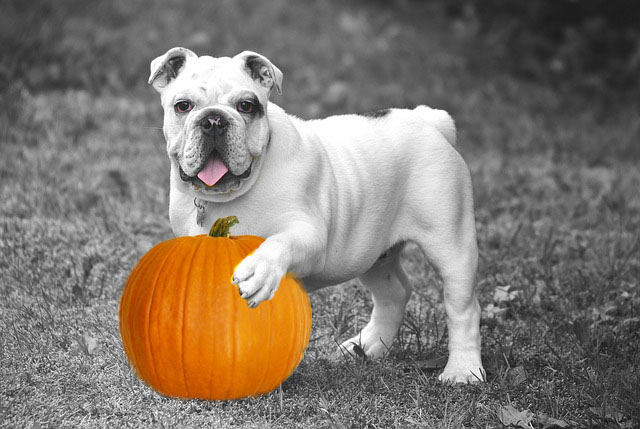
the scientific study of pet nutrition by veterinary nutrition specialists and experts.
The Problem with Pumpkin

I hear from owners (and vets) all the time that they’ve added pumpkin to their dog or cat’s diet to increase the fiber. Dog and cats don’t require any fiber in their diet but it can help animals with a variety of issues from diarrhea, constipation, diabetes, high fat levels in the blood, or to help an overweight pet feel more full. Often, pumpkin is recommended as a way to add fiber to the diet. Typically, I see people giving anywhere from ¼ teaspoon to 2 tablespoons of pumpkin at meals to increase a pet’s fiber intake. Unfortunately, this may not help and, in some cases, may cause problems.
If you wanted to give the same amounts to your pet that is found in one popular high fiber therapeutic diet, you’d need to feed more than more than 2 ½ cups of pumpkin per day to a cat and nearly 12 cups/day to a medium-sized dog!
And the miniscule amount of fiber you get in pumpkin doesn’t address the issue of fiber type. There are 2 main types of fiber in foods: soluble fiber and insoluble fiber. Soluble and insoluble fiber have different effects in the gastrointestinal tract and throughout the body. The total amount of fiber in the food is “total dietary fiber,” which is what you find on human food labels. The amount of fiber is required on all pet food labels in the guaranteed analysis section. But the guaranteed analysis only gives “crude fiber,” not “total dietary fiber.” The distinction is only in how the different kinds of fiber are measured. Crude fiber is, in fact, very crude – it only includes the insoluble fiber in the food. Depending on the type of pet food, it could have much more total fiber than the amount listed on the label, especially if that food contains primarily soluble forms of fiber. Therefore, even if 2 pet foods say they have the same amount of fiber on the label, the amounts and types could be very different. Pumpkin is a mixture of soluble and insoluble fiber, so even if you gave enough pumpkin to a cat to equal that found in a therapeutic diet, it may not be the right type of fiber.
The amount and type of fiber in pumpkin usually limit its effectiveness as a fiber source. But pumpkin also can contain ingredients that undermine a pet’s health. While canned pumpkin is only 83 calories per cup, canned pumpkin pie mix is up to 281 calories per cup due to added sugar, which can help to pack on the pounds. Too many calories from pumpkin (anything more than 10% of total calorie intake) can unbalance your pet’s diet. And canned pumpkin without salt contains only 12 milligrams of sodium per cup, but some canned pumpkin brands with salt contain nearly 600 milligrams of sodium per cup! That would be way too much sodium for a dog or cat with heart or kidney disease. Finally, pet food manufacturers don’t take this extra fiber you’re adding into account, so it may decrease how much protein and other nutrients your pet can absorb from their food, putting them at risk for deficiencies.
So, what’s a better way to add fiber to your dog or cat’s diet? Talk to your veterinarian. She can prescribe a therapeutic diet that contains increased amounts of specific types of fiber – soluble, insoluble, or a mixture of the 2, depending on your pet’s individual needs. Or, fiber supplements can be added to your pet’s food in the form of purified cellulose or wheat bran (for insoluble fiber), various over-the-counter human fiber supplements, such as inulin (for soluble fiber), or supplements that contain a mixture of both (such as psyllium). Again, it’s important to work with your veterinarian or a board-certified veterinary nutritionist to determine the specific type and amount of fiber to add to your pet’s food.
Lisa M Freeman, DVM, PhD, DACVN
Want to read more information on feeding your pet?
Subscribe to always know when we add new material!
Recommended Posts

Can Diet Help With My Dog’s Seizures?
January 18, 2024

The Most Popular Holiday Foods…That Your Pet Should Avoid!
December 08, 2023

Veterinarian Recommended Pet Foods: What You Need to Know
November 05, 2023

